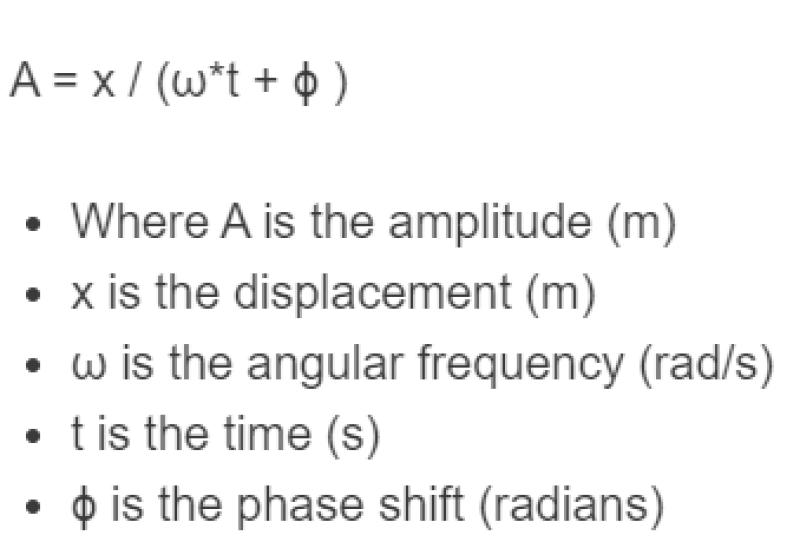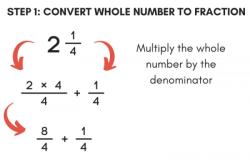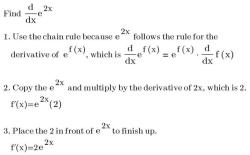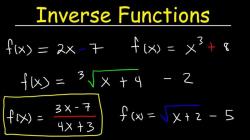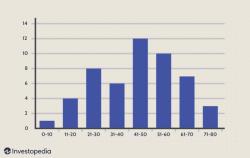What is the formula for amplitude?
In the context of waves and oscillations, the amplitude represents the maximum displacement or magnitude of the oscillating quantity from its equilibrium or rest position. The amplitude is often denoted by the letter "A." The formula for amplitude depends on the specific mathematical representation of the wave or oscillation.
Here are some common examples:
Sinusoidal Wave:
- For a simple sinusoidal wave, such as a sine or cosine wave, the amplitude is the coefficient of the trigonometric function. The general form of a sinusoidal wave is given by:
- In these equations:
- is the amplitude,
- is the angular frequency,
- is time, and
- is the phase angle.
General Wave Function:
- In more general cases, the amplitude is the coefficient of the entire oscillatory term. The wave function may take various forms, but the amplitude is still represented as .
Simple Harmonic Motion (SHM):
- In the context of simple harmonic motion, the displacement as a function of time is given by:
- In this equation:
- is the amplitude,
- is the angular frequency, and
- is the phase angle.
The amplitude represents the "height" or "size" of the wave or oscillation. It is the maximum distance the wave travels from its equilibrium position.
It's important to note that the specific form of the amplitude formula depends on the type of wave or oscillation being described. Always refer to the specific mathematical expression for the wave you are dealing with to determine the appropriate formula for amplitude in that context.
Sure, here is a comprehensive explanation of amplitude in different types of functions:
1. Defining Amplitude in Different Types of Functions
Amplitude is a crucial property of periodic functions, particularly sinusoidal functions, which exhibit repetitive oscillations. It represents the maximum displacement or deviation from the equilibrium position of the function's graph. In other words, amplitude measures the extent of the function's oscillation or variation.
Amplitude in Sinusoidal Functions
Sinusoidal functions, such as sine and cosine, are characterized by their smooth, wave-like patterns. The amplitude of a sinusoidal function is determined by the vertical distance between its midline (the horizontal line passing through the center of the wave) and its peak or trough (the highest or lowest point of the wave).
Amplitude in Sine Functions
The general equation for a sine function is given by:
y = A sin(ωx + φ) + D
where:
- A represents the amplitude
- ω represents the angular frequency
- x represents the independent variable (usually time)
- φ represents the phase angle
- D represents the vertical shift (midline displacement)
In this equation, the amplitude (A) directly determines the vertical extent of the sine wave. A higher amplitude results in a larger vertical displacement, creating a taller wave, while a lower amplitude produces a shorter wave.
Amplitude in Cosine Functions
The general equation for a cosine function is given by:
y = A cos(ωx + φ) + D
Similar to sine functions, the amplitude (A) in a cosine function determines the vertical extent of the cosine wave. A larger amplitude produces a taller wave, while a smaller amplitude results in a shorter wave.
Amplitude in Tangent Functions
Tangent functions are non-periodic and do not exhibit oscillations. Therefore, the concept of amplitude is not applicable to tangent functions. The amplitude of a tangent function is undefined.
Formulas for calculating amplitude based on function equations
For sinusoidal functions, the amplitude can be directly determined from the function's equation:
- Sine Function:
Amplitude = |A|
- Cosine Function:
Amplitude = |A|
In both equations, A represents the coefficient of the sine or cosine term, and the absolute value ensures that the amplitude is always positive.
3. Applications of Amplitude in Various Fields
Amplitude plays a significant role in various fields, including physics, engineering, and signal processing:
Physics:
In physics, amplitude is a fundamental concept in wave mechanics. It is used to describe the intensity of sound waves, light waves, and other types of waves. Amplitude is also crucial in understanding the behavior of pendulums, springs, and other oscillating systems.
Engineering:
In engineering, amplitude is essential in various applications, such as:
Electrical Engineering: Amplitude modulation (AM) and frequency modulation (FM) are techniques used in radio broadcasting to transmit signals. Amplitude is a key parameter in these modulation schemes.
Structural Engineering: Amplitude is considered in the design of structures to withstand vibrations and oscillations caused by earthquakes, wind, and other dynamic loads.
Control Systems: Amplitude is monitored and controlled in various control systems, such as those used in robotics, automation, and aerospace applications.
Signal Processing:
In signal processing, amplitude is used to analyze and manipulate signals, such as audio signals, biomedical signals, and sensor data. Amplitude measurements are used to identify patterns, remove noise, and extract meaningful information from signals.
